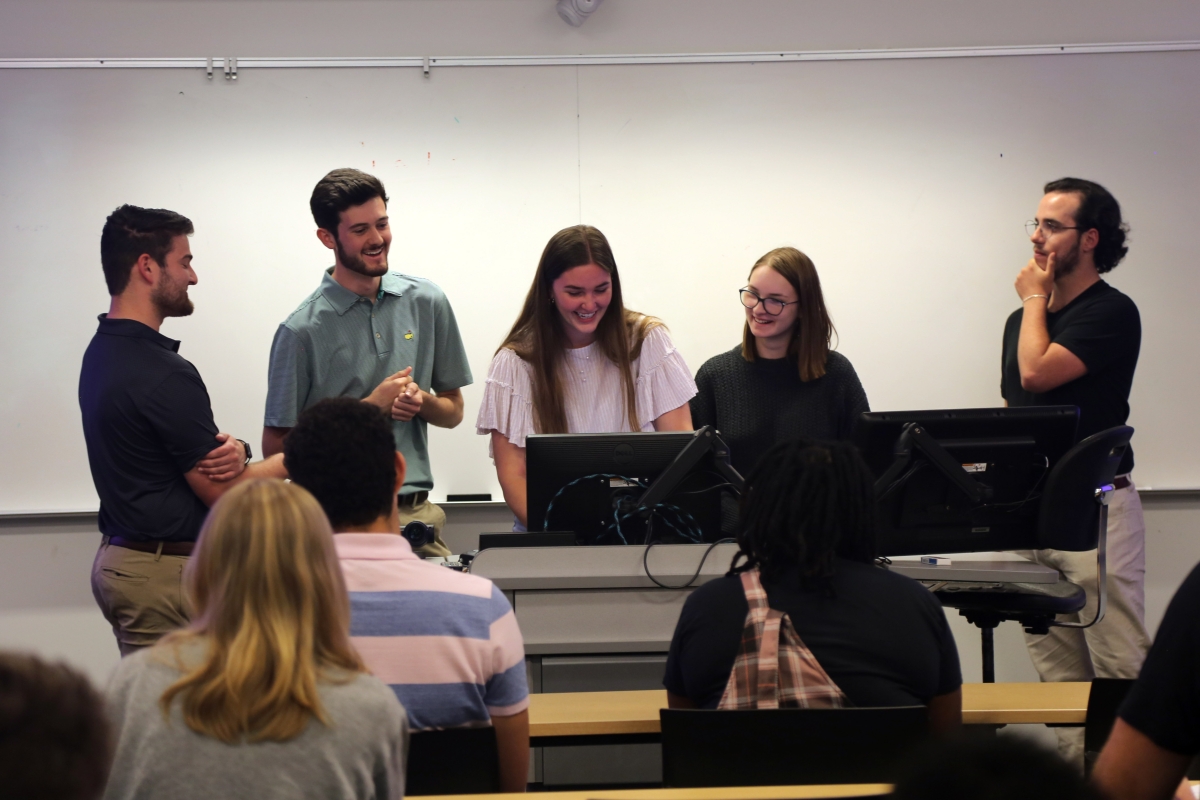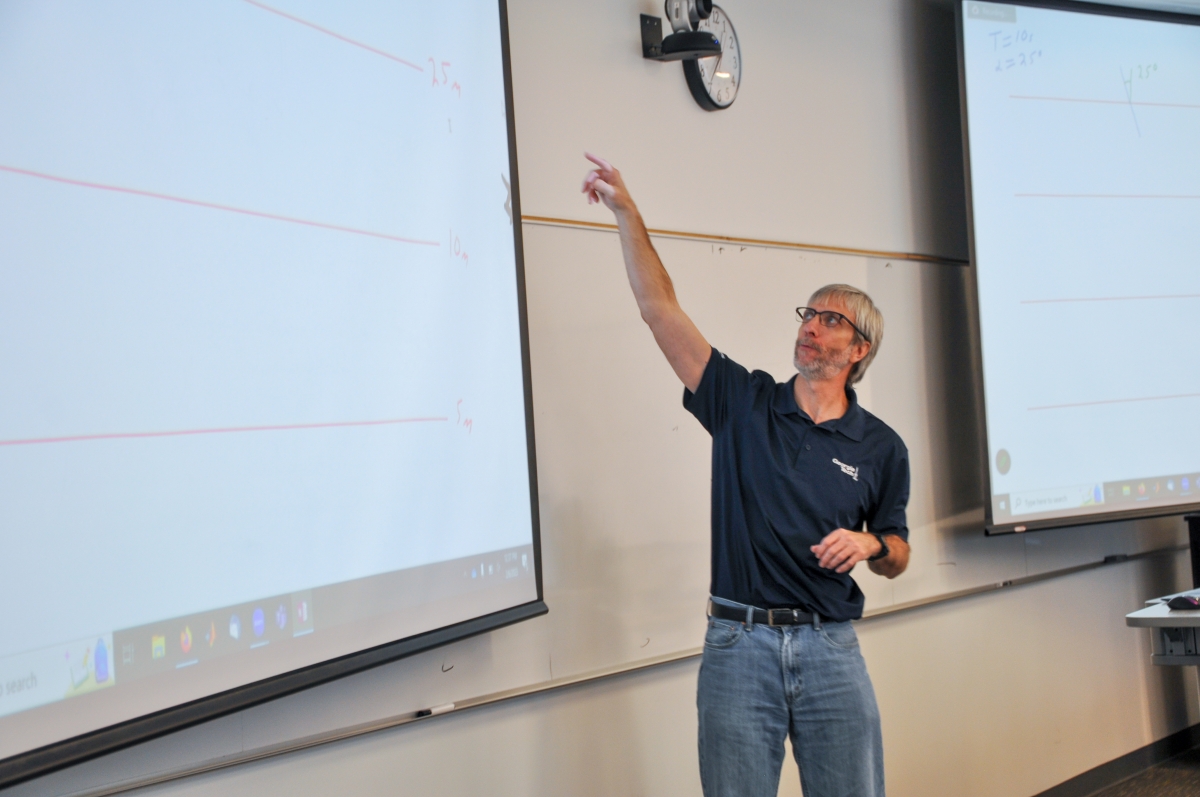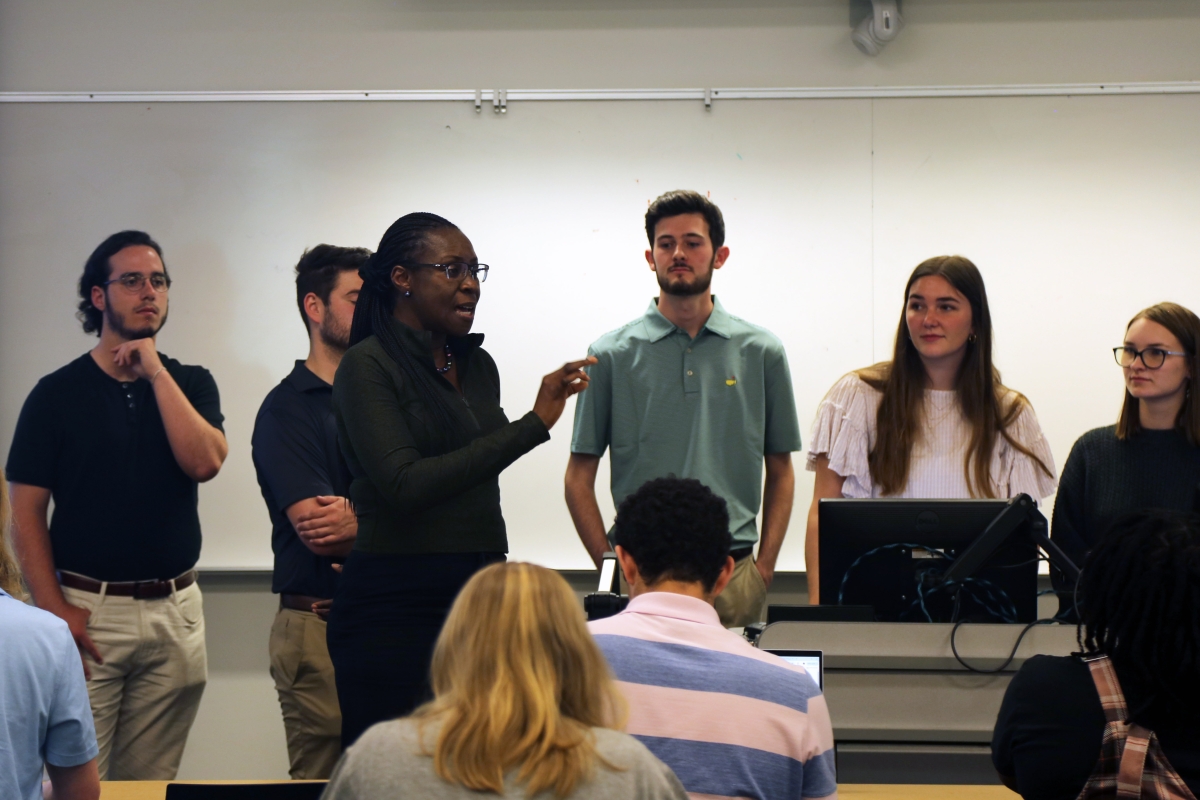Starting this year, all new civil and environmental engineering students will begin their undergraduate journey in an introductory class — creating an immediate connection to their major.
“Exploring CEE” is the first in a series of four classes that will be required courses for all undergrads, representing the School of Civil and Environmental Engineering’s most significant curriculum update in 25 years.
“I am proud of the hard work that our faculty and students have put into piloting the new and modified courses, as well as the thoughtfulness that went into evoking a major curriculum change for our undergraduate degree programs,” said Karen and John Huff School Chair Donald Webster. “The innovation is a clear expression of the strong culture in the School to support our students and deliver cutting-edge educational content and experiences.”

Students prepare for a presentation during Professor Adjo Amekudzi-Kennedy's CEE Systems course for second-year students.
From day one, first-year and transfer students will engage with civil and environmental engineering concepts and begin to build an arsenal of technical and professional skills. Each year, students will take the next in a series of courses that build upon one another. At the end of their journey, students will graduate as holistic engineers with an entrepreneurial mindset prepared for a quickly evolving world.
“We hope students come in and learn and understand what it's all about to be a civil or environmental engineer and get excited about it,” said Professor Adjo Amekudzi-Kennedy, associate chair for global engineering leadership and entrepreneurship. “They’ll be able to connect with their peers, their instructors, practitioners, and begin to craft their professional identity.”
A Spine of Courses
Behind the scenes, the School’s faculty have been engaged in a multi-pronged effort to modernize the undergraduate curriculum for more than five years.
The centerpiece is a required spine of four courses that will anchor the undergraduate experience. The vertically integrated classes, taken in sequence, focus on interactive problem-based learning around the societal grand challenges that civil and environmental engineers work to decipher, address and solve.
-
Exploring CEE provides first-year and transfer students with a broad overview of civil and environmental engineering topics, and introduces them to real-world engineers.
-
CEE Systems, for second-year students, studies the connections among infrastructure systems, sustainability, and economics.
-
Data Analytics in CEE Applications is for third-year students to use emerging computational tools to enhance the study of civil and environmental engineering.
-
Capstone Design is a course for seniors to apply their knowledge to a semester-long design project.
In addition to engineering material, the courses introduce students to skills that will set them apart in their professional lives, such as communication, collaboration, computation, reflection, and entrepreneurship.
The newest course is Data Analytics in CEE Applications, introduced as a pilot course in spring 2023. The class was designed to equip students to apply emerging technologies in machine learning and artificial intelligence in engineering contexts.
CEE Systems and Capstone Design have long been part of the School’s curriculum but have been revamped with new material and new teaching approaches.
Amekudzi-Kennedy emphasized that the recent changes involve much more than new classes. They’re about changing the way the faculty members engage with students and teach as well as broadening the mindset beyond engineering for a more holistic education.
“We are continuously looking at the overall student experience and doing internal and external reflection to see what must evolve and how must it evolve,” Amekudzi-Kennedy said. “To me, it's a culture of adaptation that we must have. It’s a culture shift.”
Professor Adjo Amekudzi-Kennedy watches her students present a project about transportation infrastructure.
We are continuously looking at the overall student experience and doing internal and external reflection to see what must evolve and how must it evolve. To me, it's a culture of adaptation that we must have. It’s a culture shift.
— Professor Adjo Amekudzi-Kennedy, associate chair for global engineering leadership and entrepreneurship
Early Engagement
Results from the course have been promising. Of those who enrolled in the course as an elective in the fall of 2023, just 15% went on to change their major — significantly lower than the roughly 50% of freshman overall that Haas recorded in 2017.
Back in 2018, Associate Chair for Undergraduate Programs Kevin Haas analyzed how many students were entering and exiting the School’s programs. What he found was that about half of students who initially declared civil or environmental engineering as their major transferred into a different major, often before they had ever taken a CEE course. Likewise, roughly half of students who ultimately earned a civil or environmental engineering degree originated in a different major before transferring into the School.
CEE leaders concluded that students weren’t learning early enough about exciting aspects of their major. They embarked on the curriculum redesign to help students more strongly identify as a civil or environmental engineer early on, to help foster a sense of belonging, and improve program outcomes.
The first step was the 2019 introduction of Exploring CEE as a pilot elective course for new students.
“We're introducing them to topics within civil and environmental engineering right at the beginning and helping them see where they can fit in within the curriculum and within the profession,” Haas said.
Former students report benefitting significantly from the class.
Nina Roush started in a different engineering program at Tech before switching her major to civil engineering. She enrolled in Exploring CEE to get a better overview of her new major and applications in the real world.
“The Exploring CEE course was not only helpful for me to learn about CEE, but also to develop professionally and become aware of many of the responsibilities that engineers have in sustaining communities economically, socially, and environmentally,” Roush said. “By the end of the course, I felt like I had a much better grasp on what the major was about and felt like I was in the right major for my career goals and interests.”

Professor Kevin Haas teaches the Exploring CEE course for first-year students.
Revolutionizing Engineering Education
Seeing momentum from the Exploring CEE course, faculty leaders wanted to do more.
In 2020, CEE received a $1 million grant from the National Science Foundation’s Revolutionizing Engineering Departments (RED) program.
The funding provided faculty with resources to expand their vision and consider how to engage undergraduate students as they matriculate over the course of four years.
In 2021, the effort was strengthened by a grant from the Kern Family Foundation’s Kern Entrepreneurial Engineering Network (KEEN). CEE was one of four College of Engineering programs selected to help students build an entrepreneurial mindset by infusing story-driven learning and other entrepreneurially-minded learning pedagogies into their curricula.
“Students who have an entrepreneurial mindset are curious, they want to see the big picture, they connect the things they are doing to the broader economy, environment, society and then they know how to create value,” Amekudzi-Kennedy said.
Amekudzi-Kennedy has led the change initiative through the two grant programs over the past few years.
She pointed out that curriculum change can be difficult — particularly when things are going well. In fact, the School received the RED grant the same year that it was named the No. 1 civil engineering program in the nation by U.S. News and World Report.
Professor Michael Hunter, Chair of the Undergraduate Curriculum Committee, led an effort to work with small groups of faculty members to get input. The process led to near unanimous support of the initiatives and recognition that the School needed to adapt to a changing world.

Professor Adjo Amekudzi-Kennedy speaks to students in her CEE Systems course.
Literature on the quickly evolving nature of the practice and education of civil and environmental engineering propelled them forward. Amekudzi-Kennedy said research from the Chronicle of Higher Education and others has confirmed that retention is higher and students fare better when they feel a sense of belonging.
Meanwhile, a 2019 American Society of Civil Engineers education summit highlighted the need to elevate professional skills to equal footing with technical skills to keep pace with a changing industry.
Luckily, the School already had a successful model to integrate those professional skills, thanks to Principal Academic Professional Lisa Rosenstein and her embedded Engineering Communications Program.
The communications program integrates written, oral, and visual communication skills within relevant and discipline-specific problems, where students learn not only skills, but also the philosophy that underpins effective communication.
As part of the professional formation component of the recent curriculum revamp, CEE followed a similar model to embed teaming skills development into all four spine courses, at increasing levels of maturity. Exercises in those classes teach students strategies for working effectively on teams, small group activities allow students to take varying roles on a team, and students learn strategies for conflict resolution and team leadership.
“With these curriculum changes emphasizing belonging and professional skills, we are building on our legacy as a forward-thinking civil and environmental engineering program,” Webster said. “I am confident that our students will graduate ready to succeed as civil and environmental engineers today and push the boundaries of the discipline into the future.”
